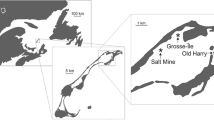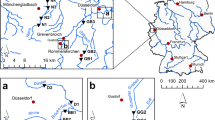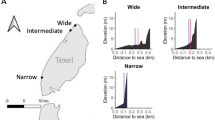Abstract
The dispersal of rhizomes by waves and ocean currents allows invasive coastal plants to spread rapidly over long distances. Long-term management of these species should recognise the potential for regeneration from rhizome fragments and the likelihood of invasion or reinvasion of dunes. Here, we assess the sprouting ability of Ammophila arenaria (marram grass), an invasive weed of temperate dune systems, which spreads by the marine dispersal of rhizomes. Rhizomes were obtained from four sites in southern New Zealand. Comparative growth trials were conducted to compare the sprouting ability of rhizomes originating from different populations, seasonal restrictions in sprouting potential, and the effects of fragment morphology (length and node number) and rhizome type (vertical or horizontal) on sprouting ability. Overall, the sprouting ability of A. arenaria is high, although we found this ability varied between populations, with season, and in relation to fragment length. Rhizomes formed shoots rapidly when fragmented, indicating a weak or limited innate dormancy. Reduced sprouting appears to be due to variation in the growth reserves stored within the rhizomes at the time of fragmentation. Large numbers of viable rhizomes will be dispersed during events that erode foredunes, and all populations of invasive A. arenaria growing within reach of waves should be considered a potential source of propagules, a conclusion that has implications for management agencies seeking to protect or restore apparently isolated dune systems.



Similar content being viewed by others
References
Aptekar R, Rejmánek M (2000) The effect of sea-water submergence on rhizome bud viability of the introduced Ammophila arenaria and the native Leymus mollis in California. J Coast Conserv 6:107–111
Ayeni AO, Duke WB (1985) The influence of rhizome features on subsequent regenerative capacity in speargrass (Imperata cylindrica (L.) Beauv.). Agric Ecosyst Environ 13:309–317
Brandsæter LO, Fogelfors H, Fykse H, Graglia E, Jensen RK, Melander B, Salonen J, Vanhala P (2010) Seasonal restrictions of bud growth on roots of Cirsium arvense and Sonchus arvensis and rhizomes of Elymus repens. Weed Res 50:102–109
Buell AC, Pickart AJ, Stuart JD (1995) Introduction history and invasion patterns of Ammophila arenaria on the north coast of California. Conserv Biol 9:1587–1593
Chapin FS III, Schulze ED, Mooney HA (1990) The ecology and economics of storage in plants. Annu Rev Ecol Syst 21:423–427
Cordazzo CV, Davy AJ (1999) Vegetative regeneration of Panicum racemosum from rhizome fragments on southern Brazilian coastal dunes. J Coastal Res 15:520–525
Cordazzo CV, Seeliger U (2003) Reproduction and vegetative regeneration in Blutaparon portulacoides (Amaranthaceae) on backshores of southern Brazil. J Coastal Res 35:481–485
Davy AJ, Figueroa E (1993) The colonization of strandlines. In: Miles J, Walton DWH (eds) Primary succession on land. Blackwell, London, pp 113–131
Disraeli DJ (1984) The effect of sand deposits on the growth and morphology of Ammophila breviligulata. J Ecol 72:145–154
Doing H (1985) Coastal fore-dune zonation and succession in various parts of the world. Vegetatio 61:65–75
Duke SO (1985) Weed physiology (volume I); reproduction and ecophysiology. CRC Press, Florida
Eldred RA, Maun MA (1982) A multivariate approach to the problem of decline in vigour of Ammophila. Can J Bot 60:1371–1380
Fant JB, Holmstrom RM, Sirkin E, Etterson JR, Masi S (2008) Genetic structure of threatened native populations and propagules used for restoration in a clonal species, American beachgrass (Ammophila breviligulata Fern.). Restor Ecol 16:594–603
Fenner M (1985) Seed ecology. Chapman & Hall, London
Gray AJ (1985) Adaptation in perennial coastal plants—with particular reference to heritable variation in Puccinellia maritima and Ammophila arenaria. In: Beeftink WJ, Rozema J, Huiskes AHL (eds) Ecology of coastal vegetation. Springer, Netherlands, pp 179–188
Greig-Smith P, Gemmell AR, Gimingham CH (1947) Tussock formation in Ammophila arenaria (L.) Link. New Phytol 46:262–268
Hacker SD, Zarnetske P, Seabloom E, Ruggiero P, Mull J, Gerrity S, Jones C (2012) Subtle differences in two non-native congeneric beach grasses significantly affect their colonization, spread, and impact. Oikos 121:138–148
Håkansson S (2003) Weeds and weed management on arable land: an ecological approach. CABI, UK
Harris D, Davy AJ (1986) The regenerative potential of Elymus farctus from rhizome fragments and seeds. J Ecol 74:1057–1067
Hayes M, Kirkpatrick JB (2012) Influence of Ammophila arenaria on half a century of vegetation change in eastern Tasmanian sand dune systems. Aust J Bot 60:450–460
Hertling UM, Lubke RA (1999) Indigenous and Ammophila arenaria-dominated dune vegetation on the South African Cape coast. Appl Veg Sci 2:157–168
Hesp PA (1991) Ecological processes and plant adaptations on coastal dunes. J Arid Environ 21:165–191
Hesp PA (2002) Foredunes and blowouts: initiation, geomorphology and dynamics. Geomorphology 48:245–268
Hesp PA, Hilton MJ (2013) Restoration of foredunes and transgressive dunefields: case studies from New Zealand. In: Martínez ML, Gallego-Fernández JB, Hesp PA (eds) Restoration of coastal dunes. Springer, Berlin, pp 67–92
Hilton MJ (2006) The loss of New Zealand’s active dunes and the spread of marram grass (Ammophila arenaria). New Zeal Geogr 62:105–120
Hilton MJ, Konlechner TM (2010) A review of the marram grass eradication program (1999–2009), Stewart Island, New Zealand. Proceedings, the New Zealand plant protection society inc. and the council of Australasian Weed Societies Inc.—17th Australasian weeds conference, 26–30 September 2010, Christchurch, pp 386–389
Hilton MJ, Konlechner TM (2011) Incipient foredunes developed from marine-dispersed rhizome of Ammophila arenaria. J Coast Res 64:288–292
Hilton MJ, Duncan M, Jul A (2005) Processes of Ammophila arenaria (marram grass) invasion and indigenous species displacement, Stewart Island, New Zealand. J Coast Res 21:175–185
Hilton MJ, Harvey N, Hart A, James K, Arbuckle C (2006) The impact of exotic dune grass species on foredune development in Australia and New Zealand: a case study of Ammophila arenaria and Thinopyrum junceiforme. Aust Geogr 37:313–334
Hol WH, van der Wurff AW, Skøt L, Cook R (2008) Two distinct AFLP types in three populations of marram grass (Ammophila arenaria) in Wales. Plant Genet Resour C 6:201–207
Hope-Simpson JF, Jefferies RL (1966) Observations relating to vigour and debility in marram grass (Ammophila arenaria (L.) Link). J Ecol 54:271–274
Huiskes AHL (1979) Ammophila arenaria (L.) Link (Psamma arenaria (L.) Roem. et Schult.; Calamgrostis arenaria (L.) Roth). J Ecol 67:363–382
Kinlan BP, Gaines SD (2003) Propagule dispersal in marine and terrestrial environments: a community perspective. Ecol 84:2007–2020
Klimeš L, Klimešová J, Čížková H (1999) Carbohydrate storage in rhizomes of Phragmites australis: the effects of altitude and rhizome age. Aquat Bot 64:105–110
Knevel IC (2001) The life history of selected coastal foredune species of South Africa. Dissertation, Rhodes University
Konlechner TM (2008) Marine dispersal of terrestrial weeds. New Zeal Geogr 64:154–156
Konlechner TM (2012) The dispersal and establishment of Ammophila arenaria from rhizomes. Dissertation, University of Otago
Konlechner TM, Hilton MJ (2009) The potential for marine dispersal of Ammophila arenaria (marram grass) rhizome. J Coastal Res 56:434–437
Konlechner TM, Hilton MJ (2010) An examination of the seed bank of Ammophila arenaria (marram grass). Proceedings, the New Zealand plant protection society inc. and the council of Australasian weed Societies Inc.—17th Australasian weeds conference, 26–30 September 2010, Christchurch, pp 390–393
Konlechner TM, Hilton MJ, Orlovich DA (2013) Accommodation space limits plant invasion: Ammophila arenaria survival on New Zealand beaches. J Coast Conserv 17:463–472
Koske RE, Gemma JN, Corkidi L, Sigüenza C, Rincón E (2004) Arbuscular mycorrhizas in coastal dunes. In: Martinez ML, Psuty NP (eds) Coastal dunes, ecology and conservation. Springer-Verlag, Berlin, pp 173–187
Liew J, Andersson L, Boström U, Forkman J, Hakman I, Magnuski E (2013) Regeneration capacity from buds on roots and rhizomes in five herbaceous perennials as affected by time of fragmentation. Plant Ecol 214:1199–1209
Lockwood JL, Cassey P, Blackburn TM (2009) The more you introduce the more you get: the role of colonization pressure and propagule pressure in invasion ecology. Divers Distrib 15:904–910
Lubke RA, Hertling UM, Avis AM (1995) Is Ammophila arenaria (marram grass) a threat to South African dune fields? J Coast Conserv 1:103–108
Marshall JK (1965) Corynephorus canescens (L.) P. Beauv. as a model for the Ammophila problem. J Ecol 53:447–463
Maun MA (1984) Colonizing ability of Ammophila breviligulata through vegetative regeneration. J Ecol 72:565–574
Maun MA (1998) Adaptations of plants to burial in coastal sand dunes. Can J Bot 76:713–738
Maun MA (2009) The biology of coastal sand dunes. Oxford University Press, London
Maun MA, Baye PR (1989) The ecology of Ammophila breviligulata Fern. on coastal dune systems. CRC Cr Rev Aquat Sci 1:661–681
Nathan R, Schurr FM, Spiegel O, Steinitz O, Trakhtenbrot A, Tsoar A (2008) Mechanisms of long-distance seed dispersal. Trends Ecol Evol 23:638–647
Owen SJ (1997) Ecological weeds on conservation land in New Zealand: a database. Department of Conservation, Wellington
Pavlik BM (1983) Nutrient and productivity relations of the dune grasses Ammophila arenaria and Elymus mollis. III. Spatial aspects of clonal expansion with reference to rhizome growth and the dispersal of buds. B Torrey Bot Club 110:271–279
Rodríguez-Echeverría S, Freitas H (2006) Diversity of AMF associated with Ammophila arenaria ssp. arundinacea in Portuguese sand dunes. Mycorrhiza 16:543–552
Slaymaker DH, Peek MS, Wresilo J, Zeltner DC, Saleh YF (2014) Genetic structure of native and restored populations of American beachgrass (Ammophila breviligulata Fern.) along the New Jersey coast. J Coast Res 31:1334–1343
Suzuki JI, Stuefer J (1999) On the ecological and evolutionary significance of storage in clonal plants. Plant Spec Biol 14:11–17
Vergiev S, Filipova-Marinova M, Trifonova E, Kotsev I, Pavlov D (2013) The impact of sea water immersion on the viability of psammophilous species Leymus racemoses subsp. sabulosus and Ammophila arenaria. CR Acad Bulg Sci 66:212–216
Weber E (2011) Strong regeneration ability from rhizome fragments in two invasive clonal plants (Solidago canadensis and S. gigantea). Biol Invasions 13:2947–2955
West CJ, Thompson AM (2013) Small, dynamic and recently settled: responding to the impacts of plant invasions in the New Zealand (Aotearoa) archipelago. In: Foxcroft LC, Pyšek P, Richardson DM, Genovesi P (eds) Plant invasions in protected areas. Patterns, problems and challenges. Springer, Dordrecht, pp 285–311
Wiedemann AM, Pickart AJ (2004) Temperate zone coastal dunes. In: Martinez ML, Psuty NP (eds) Coastal dunes, ecology and conservation. Springer, Berlin, pp 53–65
Woitke P, Kiehl A, Kühl H, Kohl JG (1997) Nitrogen and carbohydrate pools of two rhizome types of Phragmites australis (Cav.) Trin. ex Steud. Int Revueges Hydrobiol Hydrogr 82:161–168
Author information
Authors and Affiliations
Corresponding author
Additional information
Communicated by Raymond Froend.
Rights and permissions
About this article
Cite this article
Konlechner, T.M., Orlovich, D.A. & Hilton, M.J. Restrictions in the sprouting ability of an invasive coastal plant, Ammophila arenaria, from fragmented rhizomes. Plant Ecol 217, 521–532 (2016). https://doi.org/10.1007/s11258-016-0597-6
Received:
Accepted:
Published:
Issue Date:
DOI: https://doi.org/10.1007/s11258-016-0597-6




